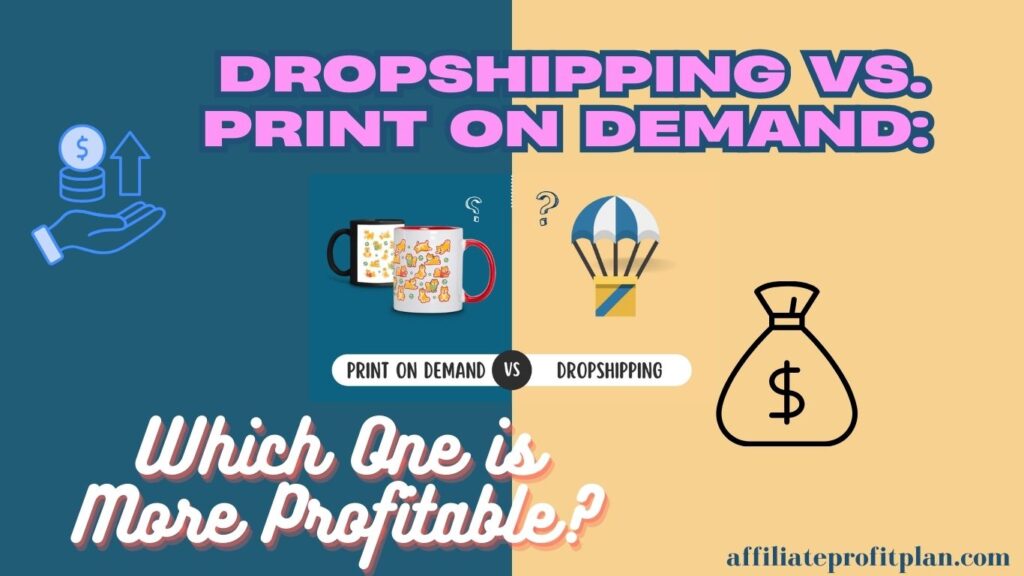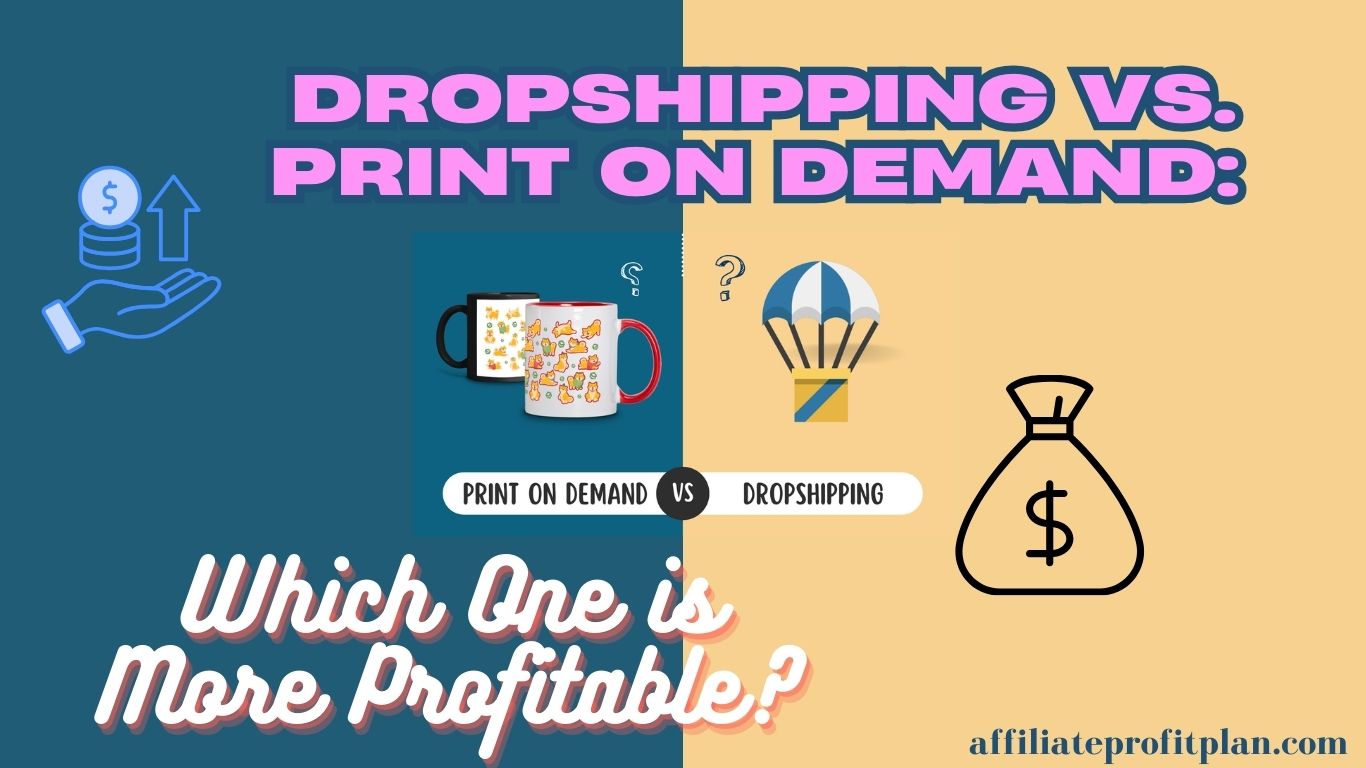Welcome to my article Dropshipping vs. Print on Demand: Which One is More Profitable? If you’ve ever dreamed of running an online business without the hassle of stocking inventory or shipping packages from your garage, you’ve probably come across dropshipping and print on demand (POD). Both are low-risk eCommerce models that let you sell products without ever touching them. Sounds like a dream, right? Well, before you quit your day job and start picturing yourself on a beach with a laptop, there’s one big question to answer: Which one actually makes more money?
So, which business model should you bet your time and money on? In this article, we’ll break down profit margins, scalability, challenges, and long-term potential to see whether dropshipping or print on demand is the better money-maker. Let’s dive in—because your bank account deserves an upgrade!
Access My Proven Blueprint for $50-$100 Daily Income – Watch This FREE Video Now >>>

Understanding Dropshipping and Print on Demand
Before we get into which business model will make it rain dollar bills, let’s break down what dropshipping and print on demand (POD) actually are. Because let’s be honest—while both sound like magical ways to make money online without handling inventory, they have some key differences that can make or break your profits.
What is Dropshipping?
Dropshipping is like running an online store—without the storage room full of boxes. You sell products from third-party suppliers, but instead of stocking them yourself, the supplier ships orders directly to the customer. Your job? Marketing and making sales—while the supplier does the heavy lifting (literally).
Pros of Dropshipping:
Huge product variety—sell anything from trendy gadgets to pet accessories.
Low upfront investment—no need to buy inventory in bulk.
Easy to test different products and pivot quickly.
Cons of Dropshipping: Lower profit margins—because you’re competing with a ton of other sellers.
Longer shipping times—especially if your supplier is overseas.
Quality control? Well, let’s just say… surprises happen.
What is Print on Demand?
Print on Demand is dropshipping’s artsy cousin. Instead of selling pre-made products, you sell custom-designed items like T-shirts, mugs, phone cases, and hoodies. When a customer places an order, the POD supplier prints your design on the product and ships it out.
Pros of Print on Demand:
Higher profit margins—because unique designs let you charge more.
No bulk inventory—you’re not stuck with 500 “I Love Avocados” T-shirts that nobody wants.
Branding opportunities—your designs can build customer loyalty.
Cons of Print on Demand:
Slower production times—each product is made after it’s ordered.
Dependent on good designs—if your designs flop, so does your store.
Limited product selection—you won’t be selling kitchen gadgets or trending TikTok products.
At first glance, dropshipping looks like the faster way to make money, while print on demand offers higher branding potential—but which one actually puts more cash in your pocket? Let’s keep going and find out.
Profit Margins: Which One Offers Higher Earnings?
Alright, let’s talk about what really matters—profit margins. Because at the end of the day, it’s not just about making sales; it’s about keeping more money in your pocket. So, which business model lets you cash in bigger profits: dropshipping or print on demand (POD)? Let’s break it down.
Dropshipping Profit Margins: More Sales, Less Profit?
With dropshipping, you’re selling third-party products, which means you have less control over pricing. The typical profit margin for dropshipping ranges from 15% to 30%, depending on your niche and supplier. Since you’re competing with tons of other sellers, you often have to lower prices to stay in the game.
What eats into dropshipping profits?
- Supplier costs: You’re buying at wholesale, but not at rock-bottom prices.
- Advertising expenses: Facebook and Google Ads can drain your budget fast.
- Refunds & chargebacks: Bad product quality? Get ready for some unhappy customers.
Dropshipping is a volume game—you have to sell a lot to make a decent profit. If you hit a viral product, great! But if your profit per sale is low, you’ll need big traffic and aggressive marketing to stay profitable.
Print on Demand Profit Margins: Fewer Sales, Bigger Cuts?
Print on demand offers higher margins per product, usually between 30% to 50%. Why? Because you’re not just selling a product—you’re selling a unique design. People are willing to pay more for custom or niche-specific items, meaning you can price higher than generic dropshipping products.
What affects POD profits?
- Base product costs: A plain T-shirt from a POD supplier might cost $10-$15 before printing, so pricing smartly is key.
- Design quality: The better (and trendier) your designs, the more people will pay.
- Branding: If you build a following around your designs, you can charge premium prices.
Unlike dropshipping, POD isn’t about selling thousands of random items—it’s about selling fewer, higher-priced products to the right audience.
So, Which One is More Profitable?
- Dropshipping: Lower profit per sale, but potential for high sales volume.
- Print on Demand: Higher profit per sale, but requires strong branding and creative designs.
If you’re great at marketing and scaling, dropshipping can bring in steady profits. But if you’re creative and can build a loyal customer base, POD can offer higher earnings per product.
The real winner? It depends on your business style. Are you the hustler who loves testing trending products, or the artist who wants to sell unique creations? Either way, the money’s there—you just need the right strategy.
Scalability and Growth Potential
So, you’ve picked a business model, made a few sales, and now you’re wondering—how big can this thing actually get? Can you scale it into a money-printing empire, or will you hit a ceiling? Let’s break down the scalability and growth potential of dropshipping vs. print on demand (POD) to see which one has the power to grow without turning into a logistical nightmare.
Access My Proven Blueprint for $50-$100 Daily Income – Watch This FREE Video Now >>>
Scaling a Dropshipping Business: Fast, But Fragile
One of the biggest reasons people jump into dropshipping is because it’s easy to start and scale. You don’t have to worry about manufacturing, warehousing, or fulfillment. Instead, you focus on finding winning products and scaling ads to drive sales.
Why Dropshipping Scales Well:
No inventory limits – You can sell 10 or 10,000 units without stocking a single product.
Automation tools – With apps like Oberlo, Spocket, or CJdropshipping, managing orders is easy.
Test and pivot quickly – If a product flops, you can swap it out and try something new.
Challenges of Scaling Dropshipping:
Supplier dependency – If your supplier runs out of stock or increases prices, you’re in trouble.
Ad costs skyrocket – The more you scale, the more you spend on ads, eating into profits.
Customer service headaches – Delayed shipping, quality issues, and refunds can hurt your brand.
Scaling a dropshipping store is all about speed—finding viral products before the market is saturated. But it’s a fragile system. A bad supplier, rising ad costs, or a PayPal hold on your funds can send everything crashing down.
Scaling a Print on Demand Business: Slow and Steady Wins the Race?
Print on demand is a different beast when it comes to growth. Since you’re selling unique designs rather than trending products, your success depends on branding, audience loyalty, and creative marketing.
Why Print on Demand Scales Differently:
Evergreen potential – A great design can sell for years, unlike trendy dropshipping products.
Brand loyalty – Customers who love your designs come back for more, reducing ad costs.
More pricing power – Unique designs mean less competition and better margins.
Challenges of Scaling Print on Demand:
Limited product variety – You can’t just add trending TikTok gadgets and cash in overnight.
Production bottlenecks – POD items are made to order, so fulfillment takes longer.
Marketing is key – If your designs don’t stand out, scaling will be tough.
Scaling a POD business is more of a long-term strategy—you’re building a brand, not just selling products. It takes time to grow a loyal audience, but once you do, you can generate consistent passive income without constantly hunting for new products.
So, Which One Has More Growth Potential?
- Dropshipping: Quick to scale, but unstable. Best for fast-moving entrepreneurs who can adapt to changing trends.
- Print on Demand: Slower growth, but more sustainable. Best for creatives and brand-builders who want long-term success.
If you want to cash in fast, dropshipping is the way to go. But if you’re in it for the long haul, POD offers a more stable, brand-driven business that can grow over time.
Challenges and Risks of Each Business Model
Alright, let’s get real for a second—no online business is 100% smooth sailing. While dropshipping and print on demand (POD) both sound like easy, low-risk ways to make money, they each come with their fair share of headaches. So before you dive in, let’s break down the biggest challenges and risks you need to watch out for.
Dropshipping: The Fast Lane with Roadblocks
Dropshipping looks like the ultimate shortcut to eCommerce success—no inventory, no upfront costs, no problem! But once you start scaling, you’ll realize it’s not all passive income and beachside laptop sessions.
Major Challenges of Dropshipping
Thin Profit Margins – With so much competition, you often have to lower prices to stay in the game, cutting into profits.
Long Shipping Times – Many suppliers are overseas (looking at you, China), meaning customers might be waiting 2-4 weeks for their orders. And guess what? They don’t like that.
Quality Control Issues – Since you never touch the product, you’re relying 100% on the supplier’s quality. And sometimes, what arrives looks nothing like the product photos.
Refund & Chargeback Nightmares – Angry customers = refund requests = potential PayPal or Stripe account freezes.
Heavy Dependence on Ads – Dropshipping relies on paid ads (Facebook, TikTok, Google, etc.), and as ad costs rise, profit margins shrink.
Biggest Risk?
Your entire business depends on third-party suppliers and ad platforms. If your supplier disappears, your ad account gets banned, or a competitor undercuts your prices—you’re out of luck.
Print on Demand: Profitable but Slow to Scale
Print on demand is a less risky model since you’re selling custom products, but that doesn’t mean it’s easy. If you think you can throw a few designs on a t-shirt and retire early, think again.
Major Challenges of Print on Demand
Lower Sales Volume – Since POD products aren’t mass-produced, they cost more per unit, meaning fewer impulse buyers compared to cheap dropshipping gadgets.
Production Delays – Unlike dropshipping, where the product is already made, POD items are created after a customer places an order, slowing down delivery times.
Design Matters… A Lot – If your designs aren’t unique, trendy, or niche-specific, they won’t sell. And no, slapping a random quote on a hoodie isn’t enough.
Limited Product Selection – With dropshipping, you can sell anything trending. With POD, you’re mostly limited to apparel, mugs, phone cases, and posters.
Branding Takes Time – POD is a long-term game. Unlike dropshipping, where you can sell whatever’s trending, POD requires an audience that loves your designs.
Biggest Risk?
If your designs don’t sell, you’re stuck spending money on ads with no return. Scaling is slower than dropshipping, and without good marketing, your store can flop.
So, Which One is Riskier?
- Dropshipping is riskier in the short term—you’re at the mercy of suppliers, ad platforms, and razor-thin margins. But if you find a winning product, you can scale quickly.
- Print on Demand is a slower burn—it’s less risky but requires strong branding, creativity, and patience to become profitable.
If you’re looking for fast cash, dropshipping might be your move—just be prepared for supplier and refund headaches. But if you want a more sustainable, creative business, POD could be your best bet. Either way, no business is 100% risk-free—the key is knowing what challenges to expect so you can avoid the biggest pitfalls.
Which One is More Profitable? (Final Verdict)
Alright, let’s get to the big question: Which business model will fatten your wallet faster—dropshipping or print on demand? If you’re looking for a one-size-fits-all answer, I hate to break it to you, but it depends (cue dramatic music). Both models have the potential to be highly profitable, but how much you make will depend on your niche, marketing skills, and ability to handle the inevitable bumps along the way. Let’s break it down.
Dropshipping: Fast Cash, But Is It Sustainable?
If you’re after quick profits, dropshipping can be a goldmine—if you play your cards right. With the ability to source trending products cheaply and sell them at a high markup, some dropshippers rake in thousands in just a few months.
How Dropshipping Makes Money:
Low upfront costs – You don’t buy inventory, so most of your budget goes into marketing.
Fast scalability – If a product goes viral, you can scale quickly and make big profits in a short time.
Impulse purchases drive sales – Trending products attract buyers without a strong brand presence.
But Here’s the Catch:
Low profit margins – Competition is fierce, and you’ll often lower prices to stay competitive.
Heavy ad dependency – If your Facebook or TikTok ads stop converting, your sales disappear overnight.
Refunds and chargebacks – Poor product quality or long shipping times = angry customers and lost profits.
Potential Profits: Successful dropshippers can earn $5,000–$50,000 per month, but it’s unstable. One wrong move (like an ad ban or supplier issue) can tank your business.
Print on Demand: Slower, But More Sustainable Profits
Print on demand isn’t a get-rich-quick scheme, but it can build long-term, passive income. Since you’re selling unique, custom-designed products, your competition is lower, and you can charge premium prices.
How Print on Demand Makes Money:
Higher profit margins – Unique designs allow you to price products higher.
Branding potential – A loyal customer base means repeat buyers and organic growth.
Evergreen sales – Unlike trendy dropshipping products, good designs can sell for years.
But Here’s the Catch:
Slow scalability – It takes time to build a brand and grow an audience.
Lower sales volume – A t-shirt with your custom design won’t sell as fast as a trending gadget.
Marketing is key – If your designs don’t connect with your audience, you won’t sell anything.
💸 Potential Profits: A well-established POD business can generate $10,000–$100,000+ per month, but it takes time to build a strong brand and repeat customers.
So, Which One is More Profitable?
If you want fast cash and don’t mind the risks, dropshipping can be highly profitable—short-term. But if you prefer long-term stability and brand-building, print on demand is the better investment.
Dropshipping = High risk, high reward (but unstable)
Print on Demand = Slower growth, but steady and scalable
At the end of the day, the most profitable business model is the one you can execute well. Whether you choose dropshipping or POD, success comes down to choosing the right niche, marketing effectively, and staying adaptable.
Conclusion: Which One Should You Choose?
So, we’ve torn apart both dropshipping and print on demand, looked at their profit potential, challenges, and scalability, and now it’s time for the final decision. Which one should you start? Well, that depends on your goals, patience level, and risk tolerance.
Access My Proven Blueprint for $50-$100 Daily Income – Watch This FREE Video Now >>>
- If you want quick profits, don’t mind handling supplier drama, and are okay with thin margins, dropshipping is your best bet. But be warned—without a solid ad strategy and supplier reliability, you could end up spending more than you make.
- If you prefer building a long-term brand, creating custom products, and having better profit margins, print on demand is the way to go. Just remember, success won’t happen overnight, and good design skills (or a great designer) are essential.
Ultimately, both business models have massive potential, but they require hard work, smart marketing, and a willingness to adapt. If you love trends and fast-moving products, go for dropshipping. If you prefer creativity and sustainable branding, stick with POD.
Or, you know… why not try both? Some entrepreneurs start with dropshipping to generate quick cash, then use that money to build a long-term POD brand. It’s not an either-or situation—you can use both strategies to maximize profits.
No matter which route you take, just start. The real difference between success and failure isn’t the business model—it’s whether or not you take action.
Thanks a lot for reading my article on “Dropshipping vs. Print on Demand: Which One is More Profitable?” till the end. Hope you’ve helped. See you with another article.










